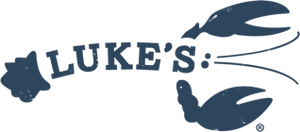Skimming the Surface:
A Guide to Our Sustainable Seafood Practices
Since its first day, Luke’s Lobster has been committed to only serving sustainable seafood, and has advocated for transparency in the food chain so that consumers know what they’re eating, who harvested it by what methods, and how it was handled from farm or dock to plate. Our commitment to sustainable ingredients has only grown, but we are now also committed to improving the other environmental impacts of our industry.
We’ve switched to buying 100% renewable energy, supported solar installations in Maine, and made aggressive efficiency improvements in our production facility as we completed our first carbon footprint assessment, which you can read more about here. We are also working directly with fishermen, wharf operators, and other seafood processors on their own efficiency projects and footprint reductions. We’re tackling waste reduction in our shacks by reducing dependence on single use items and sourcing more environmentally friendly options.
What does sustainably sourced mean? Sustainability is not a buzzword at Luke’s. Sustainable Seafood means seafood that is harvested from a healthy population that is not at risk of overfishing, under strict regulations that prevent overfishing or eco-system damage. Traceability from dock to plate is key to ensuring sustainability, and we are proud to trace every pound of seafood we sell to the harbor where it was caught so we know the regulations that bind that fishery to sustainable harvesting methods.
Lobster
🦞Maine has both minimum and maximum size restrictions for lobster that can be caught.
🦞Lobstermen throw back female lobsters bearing eggs, and put a v-shaped notch in the lobster's tail. If that lobster is ever caught again without eggs, it cannot be kept, as it is marked as a fertile breeder
🦞Lobster traps are required to have juvenile vents so small lobster can come and go to get their free lunch without risking becoming lunch themselves at the hands (claws) of a larger lobster.
🦞In Maine, there is a limited number of lobstering licenses given out to prevent overfishing, as well as a limited number of traps that are allowed to be set per lobstermen.
Crab
🦀Fishermen must throw back all egg-bearing females, ensuring that fertile crabs are kept in the population
🦀Jonah Crab may only be caught by fishermen who already hold lobster licenses or were already fishing for Jonah crab prior to 2015; no new licenses may start fishing.
🦀No more than 200 crabs per day or 500 crabs per multi-day trip can be caught incidentally through other fishing methods.
Shrimp
🦐The Eastern Canadian fishery has a quota for a total annual catch that cannot be exceeded.
🦐Trawling nets used to catch shrimp have a minimum mesh size of 40mm, which prevents juvenile shrimp from being caught, giving them time to mature and reproduce.
🦐Shrimp fishermen must use a sorting grate to ensure that they are not catching other species unintentionally.
Clams
🐚Only licensed clammers can catch sea clams, and each one has an annual maximum that they cannot exceed.
🐚Sea clams are harvested by hydraulic dredging, which has no significant effect on the seafloor ecosystem.
🐚No clams smaller than 4.75 inches can be caught to ensure that juveniles have a chance to reproduce.
<div class="dynamic-checkout__content" id="dynamic-checkout-cart" data-shopify="dynamic-checkout-cart"> <shopify-accelerated-checkout-cart wallet-configs="[{"name":"shop_pay","wallet_params":{"shopId":36382998667,"merchantName":" Luke's Lobster","personalized":true}},{"name":"amazon_pay","wallet_params":{"checkoutLanguage":"en_US","ledgerCurrency":"USD","placement":"Cart","sandbox":false,"merchantId":"A19HSX2W14S9VQ","productType":"PayAndShip","design":"C0002"}}]" access-token="7831df81aec7ebe10597f4893aa93bd4" buyer-country="US" buyer-locale="en" buyer-currency="USD" shop-id="36382998667" cart-id="461bec4f3a18e91c39d4899e3fd0c484" enabled-flags="["ae0f5bf6"]" > <div class="wallet-button-wrapper"> <ul class='wallet-cart-grid wallet-cart-grid--skeleton' role="list" data-shopify-buttoncontainer="true"> <li data-testid='grid-cell' class='wallet-cart-button-container'><div class='wallet-cart-button wallet-cart-button__skeleton' role='button' disabled aria-hidden='true'> </div></li><li data-testid='grid-cell' class='wallet-cart-button-container'><div class='wallet-cart-button wallet-cart-button__skeleton' role='button' disabled aria-hidden='true'> </div></li> </ul> </div> </shopify-accelerated-checkout-cart> <small id="shopify-buyer-consent" class="hidden" aria-hidden="true" data-consent-type="subscription"> One or more of the items in your cart is a recurring or deferred purchase. By continuing, I agree to the <span id="shopify-subscription-policy-button">cancellation policy</span> and authorize you to charge my payment method at the prices, frequency and dates listed on this page until my order is fulfilled or I cancel, if permitted. </small> </div>








